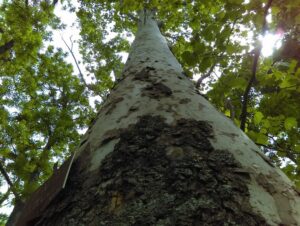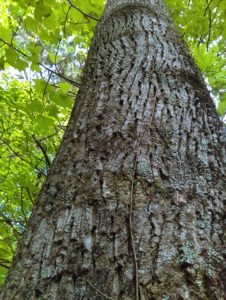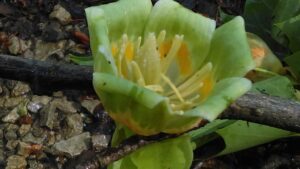By Wren Smith
On Saturday, Bernheim unofficially broke the world record for the most people hugging trees at the same time and place. It was a grand day! There is something so fitting about taking time to show some love and appreciation for all that trees add to our lives. Perhaps we owe our very lives to these graceful giants. While I joined in on the “official” hug, I must admit that I have been a tree hugger from as far back as I can recall. There was a black cherry behind our house that I’d climb whenever my childhood world was troubled. Watching the tent caterpillars that the tree hosted each summer and the birds feasting on the small reddish black cherry allowed the troubles in the adult world to fade, and was somehow comforting.

The sycamore with its anaconda like roots growing on and in the bank of a nearby creek was too big for small arms to hug, but my barefoot toes still remember the smoothness of the roots that held the creek bank in place, and how those roots formed a deep bowl of water for small minnows, frogs and whirlygig beetles.

On the Bent Twig Trail, there are many trees that are huggable, but the one that I most often stop to hug is a large tulip tree, sometimes called yellow poplar. Leriodendron tulipefera is our tallest straightest hardwood. It is also the State Tree of Kentucky, an honor once bestowed on the Kentucky Coffeetree, which now holds the title of our Kentucky State Heritage Tree. I prefer the name tulip tree over yellow poplar because the tree is actually a member of the magnolia family, and not actually a poplar. Many of the early barns and cabins in Kentucky were build from these massive trees. The beautiful double-crib barn at Blackacre Nature Preserve is an excellent example. The wood is somewhat resistant to termites and thus can last for centuries.
The bark of young tulip trees makes lovely traditional berry baskets, and the inner bark material not only for woven baskets, but also for cordage (rope).

As a beekeeper, I love the fact that the tulip-like blossoms, that inspired both the common name tulip tree, but also both the genus and species name, are like cups of nectar of our bees. Our bees have their own way of thanking these trees, they help pollinate them.
Want more Tales from Bent Twig? Click here to view the archive.

